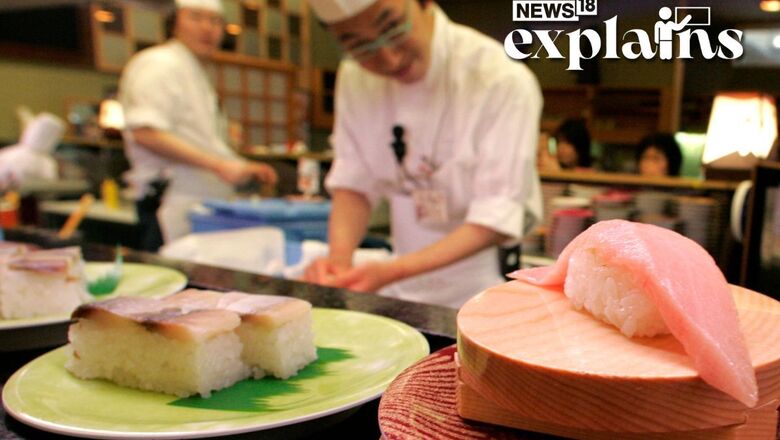
views
Three people have been arrested in Japan over ‘sushi terrorism’ in Japan, which has sparked outrage online.
Sushi is a Japanese dish made of small balls or rolls of vinegar-flavoured cold rice served with a garnish of vegetables, egg, or raw seafood. But many are wondering what ‘sushi terrorism’ could possibly mean, and what the crime committed here actually is.
News18 Explains:
The ‘terror activities’ constitute unhygienic pranks at a conveyor-belt sushi restaurant after footage of their antics — dubbed “sushi terrorism” — sparked outrage online.
Viral “sushi terror” pranks are making restaurants in Japan question whether or not conveyor belts are a good idea. pic.twitter.com/yI3pqejbSV— LX News (@NBCLX) March 10, 2023
Police accused the young trio of seeking to obstruct business at major restaurant chain Kura Sushi, which was bombarded with customer complaints after the video went viral.
Japan’s Sushi Conveyor Belts
The Japan Guide reports that Kaitenzushi are known as conveyor belt sushi or sushi trains. It is a “convenient and affordable type” of sushi restaurant in which a conveyor belt winds through the restaurant, and carries plates of sushi past the diners, who can take whatever they wish. The starting price of a plate is about 100 yen and is considered to be cheaper than the ‘conventional sushi-ya,’ the report says.

According to a report by Firstpost, the practice of conveyor-belt sushi began in 1947 when Osaka restaurateur Yoshiaki Shiraishi visited an Asahi factory and saw a winding stream of beer bottles floating across the brewery’s filling floor on a conveyor belt. He wanted to adopt the same technology at his sushi eatery and after years of fine-turning, opened Mawaru Genroku, the world’s first kaiten-sushi restaurant in 1958.
As per the report, the trend took off in Japan in the mid-1970s. This was when Shiraishi’s original patent on the conveyor belt expired, and imitators entered the market. When the 1990s saw the nation’s economy cooling, the form took on interest against, and such chains began to Asia, Europe, and the Americas, as well.
What Did the Pranksters Do?
The clip shows one member of the group grabbing a piece of sushi from a plate as it passes, shoving the whole morsel into their mouth and then drinking soy sauce directly from a communal bottle.
Similar videos filmed at different chains surfaced last month on platforms including Twitter and TikTok, with some apparently weeks or even years old, AFP said in its report.
Other unsavoury pranks included customers touching moving pieces of sushi with a freshly licked finger, or sucking the rim of a teacup before placing it back on a shelf.
Local police told AFP on Thursday that three people from the central Aichi region had been arrested.
A police spokesman said 21-year-old Ryoga Yoshino and an unnamed 15-year-old girl were arrested Wednesday, while the group’s third member, a 19-year-old man whose identity was also withheld, was collared last month.
The arrests are believed to be the first in the saga which caused an uproar in Japan, a country with famously high standards of cleanliness.
The group’s antics forced employees at Kura Sushi to perform emergency cleaning, “making normal business operations difficult,” the police spokesman added.
What Effect Did These Pranks Do?
Such stunts “have set off a national wave of revulsion in Japan, known for its exacting standards of both hygiene and politeness,” Michelle Ye Hee Lee and Julia Mio Inuma told The Washington Post.
Some eateries have also suffered financial setbacks since the videos went viral. The incident caught on camera at the Gifu eatery led to stocks in the restaurant’s parent company to plunge nearly five per cent, said the Firstpost report.

Some restaurants have completely abandoned the conveyer belts, said Firstpost in its report, while others are attempting to prove to customers their cleanliness standards.
The Washington Post reported that Kura, another popular chain, took a different approach by upgrading its artificial intelligence-assisted cameras to detect suspicious activity, “like if a customer removed a single-serving plate from the conveyor belt and then put it back.”
In case of such an instance, an alert would be sent to the company’s regional office, where employees would be able to view the footage and contact the restaurant where it happened, as per Sora News 24.
With inputs from AFP
Read all the Latest Explainers here



















Comments
0 comment